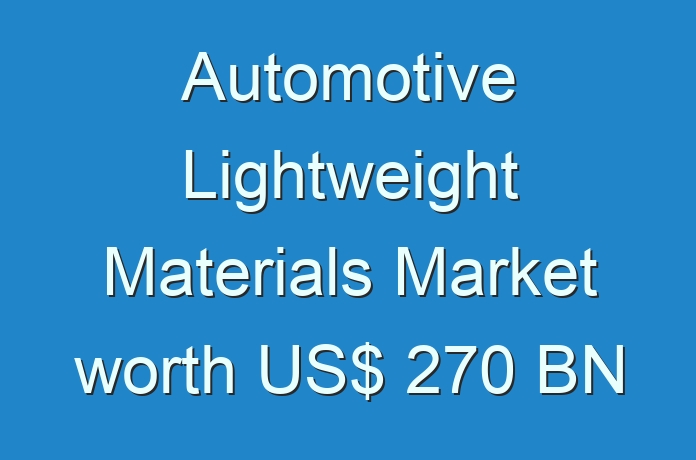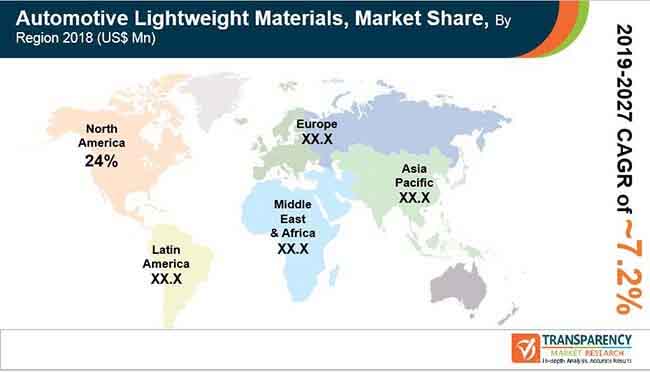
Automotive Lightweight Materials: Description
- Automotive lightweight materials play an important role in boosting the fuel economy of automobiles. These materials also enhance safety and the overall performance of vehicles.
- The fuel efficiency of a vehicle increases if it is lighter in weight, as less energy is required to accelerate a lighter object than a heavier one. With the use of automotive lightweight materials, the fuel economy of a vehicle may improve by 6% to 8% with a 10% decrease in weight.
- Replacement of cast iron and traditional steel components with lightweight materials such as high-strength steel (HSS), magnesium and aluminum alloys, and polymer and carbon fiber composites can significantly lower the vehicle weight. This, in turn, decreases its fuel consumption.
- The automotive lightweight materials market was valued at about US$ 149 Bn in 2018 and is projected to expand at a CAGR of 7.2% during the forecast period.

To gauge the scope of customization in our reports Ask for a Sample
What are Key Growth Drivers of Global Automotive Lightweight Materials Market?
- The global automotive lightweight materials market is anticipated to expand at a significant pace during the forecast period. Growth of the market can be attributed to increase the demand for automotive lightweight materials from developing countries. Factors such as stringent government regulations and rise in the demand for automotive lightweight materials from the automotive industry are boosting the market.
- Surge in the demand for automotive lightweight materials for use in lightweight vehicles is a major driver of the market. Increasing use of lightweight materials has helped achieve higher fuel economy. The factor of weight reduction is appealing for automakers, as it tends to enhance other performance factors valued by customers. Demand for vehicles is increasing at a rapid pace, especially in developing countries.
- Mandatory emission control by governments is a major factor driving the adoption of lightweight vehicles. Emission criteria vary from region to region. In the U.S. and Canada, these are based on the vehicle size and hence, entail the incorporation of aluminum in the vehicle body. In Rest of World, these criteria are based on vehicle weight, which leads to utilization of high-strength steel.
Get an idea about the offerings of our report from Report Brochure
What are Key Challenges for Global Automotive Lightweight Materials Market?
- The cost associated with lightweight materials is high. Some lightweight materials such as carbon fiber reinforced plastics (CFRP) and glass fiber reinforced plastics (GFRP) are costly compared to other traditional materials such as steel and aluminum.
- Carbon fiber composites currently cost 1.5 to five times more than steel. High fiber production costs inhibit high volume deployment. Thus, there is a need to reduce precursor and processing costs.
- Composites offer significant improvements over metals in specific strength and stiffness, creating a myriad of opportunities. However, they are more expensive. Composites typically consist of matrix and reinforcement materials. Their cost is usually dependent on the individual prices of these two materials. Reinforcements include carbon fiber and glass fiber. The high price of carbon fibers restricts the potential use of composites in many applications. Therefore, the high cost of composites is likely to considerably restrict the market.
More Trending Reports by Transparency Market Research – https://www.prnewswire.co.uk/news-releases/increasing-production-of-crude-oil-set-to-propel-tall-oil-fatty-acid-market-forward-tmr-806992482.html
Lucrative Opportunities for Players in Global Automotive Lightweight Materials Market
- To meet fuel economy and CHG emission norms, automakers are constantly changing the material makeup of their products. The inclusion of lightweight materials in vehicles will require new investments on assembly lines.
- Automakers have to retool and recalibrate their facilities in order to handle new materials. Meanwhile, automotive suppliers, in an attempt to keep up with the higher demand from automakers, will continue to expand their existing plants as well as build new facilities.
- In the U.S., the demand for carbon fiber from BMW and demand for aluminum from Ford have led to new investments in plants that supply those materials. Although lightweight materials are creating some new opportunities in the material supplier space, there are also many more opportunities in the overall material supply chain.
- Responding to the increase in demand for aluminum and composites, suppliers are working to increase their capacities. For instance, Alcoa is one of the largest producers of aluminum. It is investing US $ 300 Mn to build a new production line in Davenport, Iowa and US$ 275 Mn to add more capacity in the plant in Alcoa, Tennessee.
- All parts of the supply chain change due to a change in materials. For instance, the areas of design engineering, tooling, prototype development, fabrication, and joining are likely to offer significant opportunities as automakers continue the push for vehicle weight reduction.
Looking for Regional Analysis or Competitive Landscape in Automotive Lightweight Materials Market, ask for a customized report
Asia Pacific to Dominate Global Automotive Lightweight Materials Market
- In terms of consumption, Asia Pacific holds a major share of the global automotive lightweight materials market. The automotive lightweight materials market in Japan and China is anticipated to expand at a rapid pace during the forecast period, due to growth of the automotive industry in these countries.
- China is a major consumer of automotive lightweight materials in Asia Pacific. Middle East & Africa and Latin America are emerging markets for automotive lightweight materials. High demand for lightweight vehicles in these regions is fueling the market in Middle East & Africa and Latin America.
Leading Players in Global Automotive Lightweight Materials Market
- The global automotive lightweight materials market is highly fragmented. Major players operating in the automotive lightweight materials market are
- DuPont
- Henkel AG & Co.
- KGaA
- NovaCentrix
- Vorbeck Materials Corporation, Inc
- Intrinsiq Materials, Inc.
- Heraeus Holding GmbH
- Johnson Matthey PLC,
- Creative Materials Inc.
- Applied Ink Solutions.
- Market players are developing new products to widen their consumer base. This is likely to intensify the competition in the global automotive lightweight materials market in the next few years.
Request for covid19 Impact Analysis – https://www.transparencymarketresearch.com/sample/sample.php?flag=covid19&rep_id=8509





